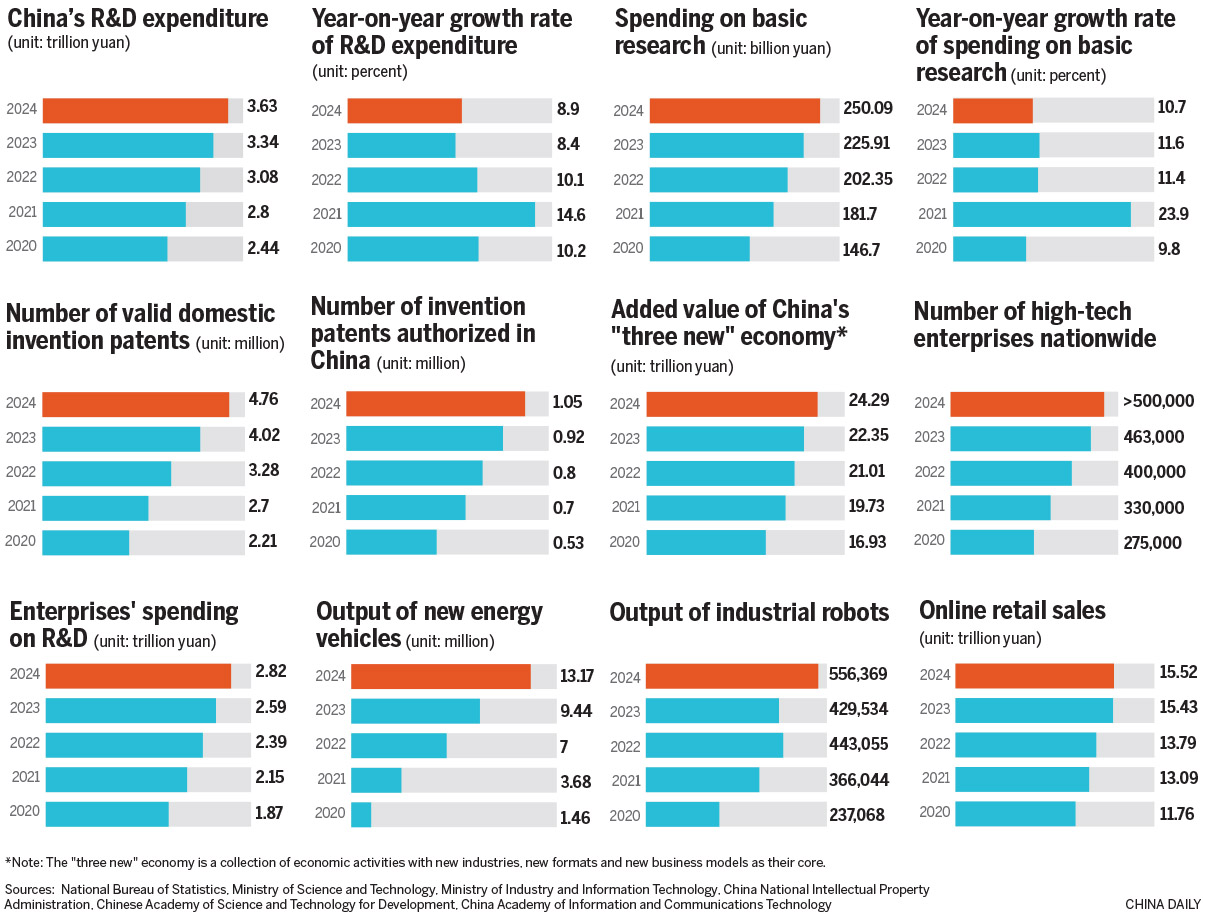Nation has thrived in electric vehicles, aerospace and other areas, experts say

China intensified efforts to bolster the integration of sci-tech innovation and industrial innovation, with notable strides made in key and core technologies, as part of its broader push to drive the development of new quality productive forces during the 14th Five-Year Plan period (2021-25).
Experts said the country has sent a clear signal that it is dedicated to implementing the innovation-driven development strategy to achieve greater self-reliance and strength in science and technology, boosting its core competitiveness globally and injecting strong momentum into high-quality economic growth amid external uncertainties.
Over the past five years, China's innovation capacity has steadily improved, and its foundation for becoming a technological powerhouse has been continuously strengthened.
READ MORE: China tax data shows fast development of new quality productive forces
The country's investment in sci-tech has continued to rise, with its research and development expenditure exceeding 3.6 trillion yuan ($505 billion) in an increase of 48 percent compared with 2020, said Minister of Science and Technology Yin Hejun.
R&D intensity reached 2.68 percent, surpassing the average level of European Union countries, while the total number of people engaged in R&D ranked first in the world, Yin said, adding that China's spending on basic research stood at 250.09 billion yuan last year, a rise of more than 70 percent compared with 2020.
Rise in rankings
China has achieved significant breakthroughs in innovation, including in quantum science, life sciences, material science, and space science, he said. It has topped the world in the number of high-level international journal papers and the volume of global patent applications for five consecutive years.
The ranking of the country's comprehensive innovation capability rose from 14th in 2020 to 10th in 2024, Yin noted. China has established the strategic goal of building a strong country in science and technology by 2035, and accelerated the realization of high-level self-reliance in science and technology.
The integration of China's sci-tech innovation with industrial innovation gathered pace during the 14th Five-Year Plan period (2021-25). Data from the National Bureau of Statistics showed that the value-added output of high-tech manufacturing enterprises — each with an annual main business revenue of at least 20 million yuan — is up 42 percent compared with the end of the 13th Five-Year Plan period (2016-20).
The added value of new industries, new business formats and new business models, dubbed the "three new" economy, accounted for 18 percent of the country's GDP last year. Tech frontiers such as artificial intelligence and biotechnology are emerging as new drivers for economic growth.
The innovation capabilities of Chinese enterprises have been significantly elevated over the past five years. In 2024, a total of 524 Chinese mainland enterprises ranked among the world's top 2,000 industrial enterprises in terms of R&D investment, accounting for 26.2 percent of the total, which represented an increase of 4.8 percentage points from 2020.
The number of high-tech enterprises exceeded 500,000 last year, an 83 percent increase from 2020.
China has accelerated steps to achieve breakthroughs in key technologies in areas including high-end equipment and advanced manufacturing, and promoted the transformation of traditional industries to higher-end, smarter, and greener ones to build a modern industrial system and nurture new quality productive forces.
It has also made great efforts to boost the development of emerging industries and future-oriented industries, such as new-generation information technology, new energy, artificial intelligence and brain-computer interface technology to gain a competitive edge and build up new growth drivers amid fierce international competition.
For instance, in the rapidly advancing AI domain, China has developed a number of general large language models that have reached an advanced international level, creating more than 100 exemplary application scenarios, Yin said.
He added that technological breakthroughs in humanoid robots have sped up their applications in automobile manufacturing, logistics and power inspection, laying a solid foundation for the development of a trillion-yuan industry.
Li Lecheng, minister of industry and information technology, said China has quickened the pace of the industrial upgrade, with the added value of equipment manufacturing and high-tech manufacturing sectors rising at an average annual rate of 7.9 percent and 8.7 percent, respectively, from 2020 to 2024.
Last year, the country's production of new energy vehicles exceeded 13 million units. China has maintained its position as the world's largest manufacturer and seller of NEVs for 10 consecutive years, Li said, highlighting that the production of photovoltaic and wind power equipment also ranked among the top in the world.

Building strengths
China has also achieved significant progress in the major technical equipment sector.
The domestically developed C919 aircraft has entered commercial service. China's first domestically built cruise ship is now in operation, and the CR450 high-speed train has rolled off the production line.
During the 14th Five-Year Plan period (2021-25), the real economy accelerated integration with the digital economy. Li said China has built the world's largest and most extensive network infrastructure, with 4.598 million 5G base stations in operation.
The 5G technology has been deployed across various fields such as mining, ports, and factories, while the number of connected devices on major industrial internet platforms exceeds 100 million units, Li said. The country has established more than 60 national advanced manufacturing clusters in emerging industries and 23 national innovation demonstration zones.
It is noteworthy that the number of AI enterprises and the scale of the AI industry in China have continued to grow over the past five years. Domestic large models such as DeepSeek and Alibaba's Qwen take the lead in the global open-source innovation ecosystem.
AI-powered devices such as AI smartphones and AI glasses are rapidly gaining popularity, while industry-specific large models are being applied in various scenarios, according to the MIIT.
Li also emphasized that enterprises' dominant position in technological innovation has been reinforced. "Enterprises' spending on R&D now accounts for more than three quarters of the country's total R&D expenditure. The number of invention patent applications filed by industrial enterprises increased from 907,000 at the end of the 13th Five-Year Plan period (2016-20) to 1.244 million last year."
Critical period
Huang Hanquan, head of the Chinese Academy of Macroeconomic Research, said China's emphasis on nurturing new quality productive forces and its significant achievements in sci-tech innovation are conducive to speeding up the establishment of a modern industrial system, enhancing the stability and resilience of industrial and supply chains, and strengthening the capacity to buffer against external shocks and challenges.
He underscored the importance of giving full play to the role of enterprises, especially small and medium-sized ones, in bolstering sci-tech innovation, accelerating the industrial application of innovation achievements, and strengthening the training of high-level talent.
"The key to developing new quality productive forces lies in achieving high-level self-reliance and strength in sci-tech, reinforcing original and disruptive technology innovations, and giving birth to new industries and new growth momentum," said Deng Zhonghan, an academician of the Chinese Academy of Engineering.
ALSO READ: Party plenum to shape next five-year plan
Noting that China is now in a critical period of innovation-driven development, Deng said it is of vital significance to support growth of tech startups through financial technology tools and step up R&D in emerging industries and future-oriented industries.
In the face of increasingly fierce international competition, technological innovation and self-reliance in sci-tech are crucial for realizing Chinese modernization, said Qi Xiangdong, chairman of Chinese cybersecurity company Qi-Anxin Technology Group, adding that his company will pour more resources into pioneering sci-tech innovation.
"China is not only a manufacturing powerhouse, but also a global innovation powerhouse driving trends in digitalization, sustainability and high-tech industries," said Denis Depoux, global managing director of market consultancy Roland Berger. "We have seen China leapfrogging in some new areas such as electric vehicles, energy storage, aerospace, solar photovoltaics and wind energy."
China has emerged as a strong player in the global R&D landscape, and has made rapid progress in the development of AI technology, becoming one of the global leaders, and the pace will further accelerate, Depoux added.
Contact the writers at fanfeifei@chinadaily.com.cn


